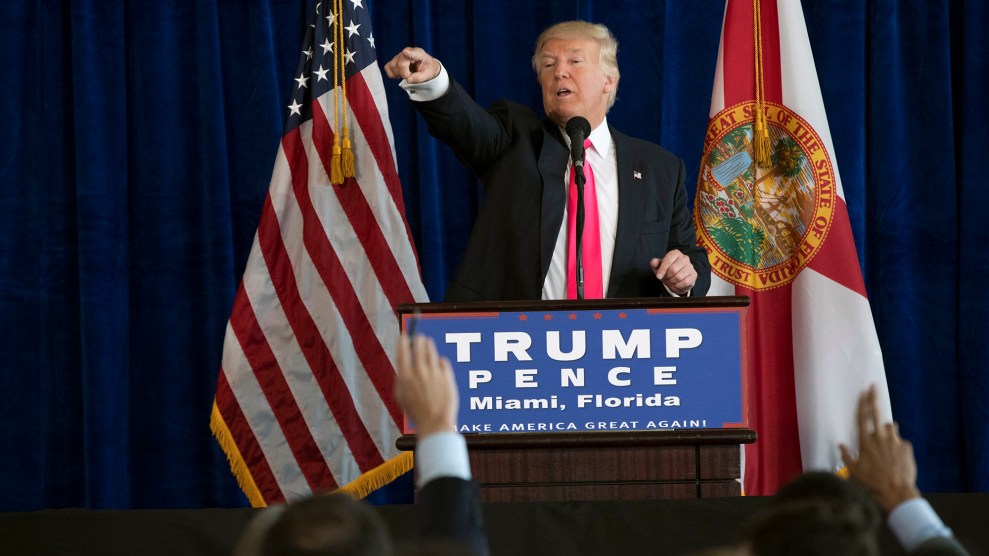Late last Friday, when social media was full of post-inauguration tea-leaf-reading, a few of us at the MoJo office found ourselves drawn into a rabbit hole of tweets about photos of Trump in the Oval Office. Wow, he had installed golden drapes! How…Versaillean. And what about that painting of a flag-bedecked street on the wall? It was Fifth Avenue in the Rain, created by the impressionist Childe Hassam amid intense nationalist fervor just as the United States was about to enter World War I. We mentally started composing tweets with ominously succinct openers: “Pay attention.” “Important.”
Then we splashed some cold water in our faces. Did we actually know that any of this was significant? We poked around a little more and found Obama photographed in front of some gold Oval Office drapes (as well as a rainbow of others). And that painting? Right there next to Obama, too.
You might have found yourself similarly tumbling through freak-outs big and small this first week of the Trump administration—and for good reason. It felt as if every minute brought more head-spinning news. The White House website overhauled; a passel of radical executive orders; National Park Service Twitter accounts seemingly going rogue, then retreating; a boundless obsession with crowd photos; leaks, drama, more tweets, more drama.
And all of it was a BFD. All of it got people hitting ALL CAPS, deploying expletives, ominously quoting Hannah Arendt and Solshenitsyn, and demanding outrage.
But not every single thing that happened this week was in the OMG SHOCKER UNPRECEDENTED category. And that’s important to remember—because people who care about democracy have never needed clear heads more than now. We need to retain the ability to pick out signal from noise, Defcon One from Defcon Five.
We saw three kinds of developments this week—let’s call them normal, normalesque, and definitely not normal. The first kind is simply part of the shift in power to another president and party: changes that could just as easily happen with (just for the sake of argument) a President Warren replacing Trump in 2021. Overhauling the White House website, freezing regulations, and even telling federal workers not to tweet fall, sort of, into this category.
The second category are policy changes more radical than what we would have seen from other GOP presidents, because today’s GOP is more radical. Those changes will in many cases mobilize shock and opposition—even from some in the Republican Party itself. Announcing the border wall, expanding the “global gag rule,” repealing Obamacare, banning immigrants for their nationality alone, even nominating cabinet members who disagree with the mission of the agencies they will lead are in this category. They will get, and deserve, a bitter fight on policy grounds, but they are still on the (far end of) the spectrum of what we can expect in a democracy at a time of tectonic political shifts. They are normalesque.
But then there is a third category—the actions of a man with a temperament and behavior we haven’t seen in the White House in modern times, if ever. Trump personally, as near as we can tell, believes in few things except himself; his actions are often precipitated by rumors and stuff on TV that makes him mad; and most significantly he, along with many of his closest advisers, is inclined toward authoritarianism and a retrograde sort of nationalism. The actions that flow from these qualities are the ones that transcend normalcy entirely. Insisting that the constitution doesn’t apply when you don’t want it to; chastising the press for reporting obvious facts and calling it “the opposition party”; perpetuating a massive smear against the electoral system by claiming that millions voted illegally; and tapping an enabler of white supremacists to set immigration policy in defiance of the agencies charged with implementing it: Those things are not even at the outside edges of normal. Those things draw from another playbook—not that of democracy.
So. What to do?
One of the most important things at a turbulent moment like this is to step back: to sift signal from noise and consider which developments rattle the foundations of democracy and which are simply the fallout from a change election.
But stepping back is hard for many reasons—not least of them the fact that many media outlets are incentivized to keep us at Defcon One. The 2016 campaign turned “fake news” into a household word, but outright manufactured smears aren’t the only problem: Weak news—decontextualized, unverified, sensationalized bits of outrage-bait—is just as much of a danger. And here, we can’t just blame Macedonian teenagers or Russian bots. Weak news is what happens when media are under pressure to grab eyeballs by appealing to our fears and preconceptions: SEE? TOLD YOU!! YOU WON’T BELIEVE WHAT THEY JUST DID.
That’s a frame of mind many who oppose Trump are in now, for good reason, and predators and hucksters are going to see a big opportunity. They are going to want to gin up falsehoods to hook you. They will send emails demanding that you FORWARD THIS TO ALL YOUR FRIENDS, tweets begging you to RT IF YOU AGREE. Some of them will be mercenaries looking for ad dollars. Some will be aiming to deluge you with fake petitions. Some will even be earnestly pushing stories they believe prove the worst (but that actually get well out past what’s known). All of them will be creating a fog of outrage and anger that obfuscates a reality very much in need of focused vigilance.
Here at Mother Jones, we hope we can be part of helping you sort weak and fake news from real, and outrage-bait from true outrage. We’ve been going after difficult, dangerous stories for more than 40 years, and we know that our research has to be solid, because people will want to impugn all of our work for the slightest error. We check and recheck sources and context; our bigger investigations go through many weeks of painstaking fact-checking. (One of our former researchers describes the process here.) We publish facts, not rumors.
Case in point: Before the election, we learned that a veteran intelligence professional had compiled allegations that Russia long sought to infiltrate Trump’s team and put together compromising information about him. We didn’t publish the specific allegations because we could not independently verify them. But the fact that a credible intelligence professional was worried enough to pass them along to the FBI was newsworthy, and we reported on that. (Last weekend, the New York Times‘ public editor, Liz Spayd, noted that Mother Jones‘ story “offered a model” of what the Times—which had the information, too, but sat on it—could have done.)
We could get lots of attention and web traffic by breathlessly passing along every sensational bit floating around the internet. But we won’t, and we don’t have to—because there aren’t shareholders or owners pressuring us to maximize profit (or, for that matter, warning us against interfering with powerful interests). We are in business because readers choose to invest in real research and reporting, and because you want it to reach a wide audience.
So here’s one way to both push back against fake news and weak news, and reduce the noise in your feed or inbox: Sign up for our free email newsletters (the sign-up form is at the top of the page), and we’ll send you hand-picked, accurate reporting four times a week. (Or you can pick which of our newsletters—on politics, environment, food, and weekly highlights—you want.) If you do, let us know what you think—and share it with your circles.
Steve Bannon, Trump’s chief strategist, says the press should “keep its mouth shut.” No. Here at MoJo, we’re doubling down on the stories that matter the most, and getting them out to people who don’t intend to shut up. When the administration labels the press as the “opposition party” and talks about “alternative facts,” they want you to believe there is no such thing as truth. They will fail.













